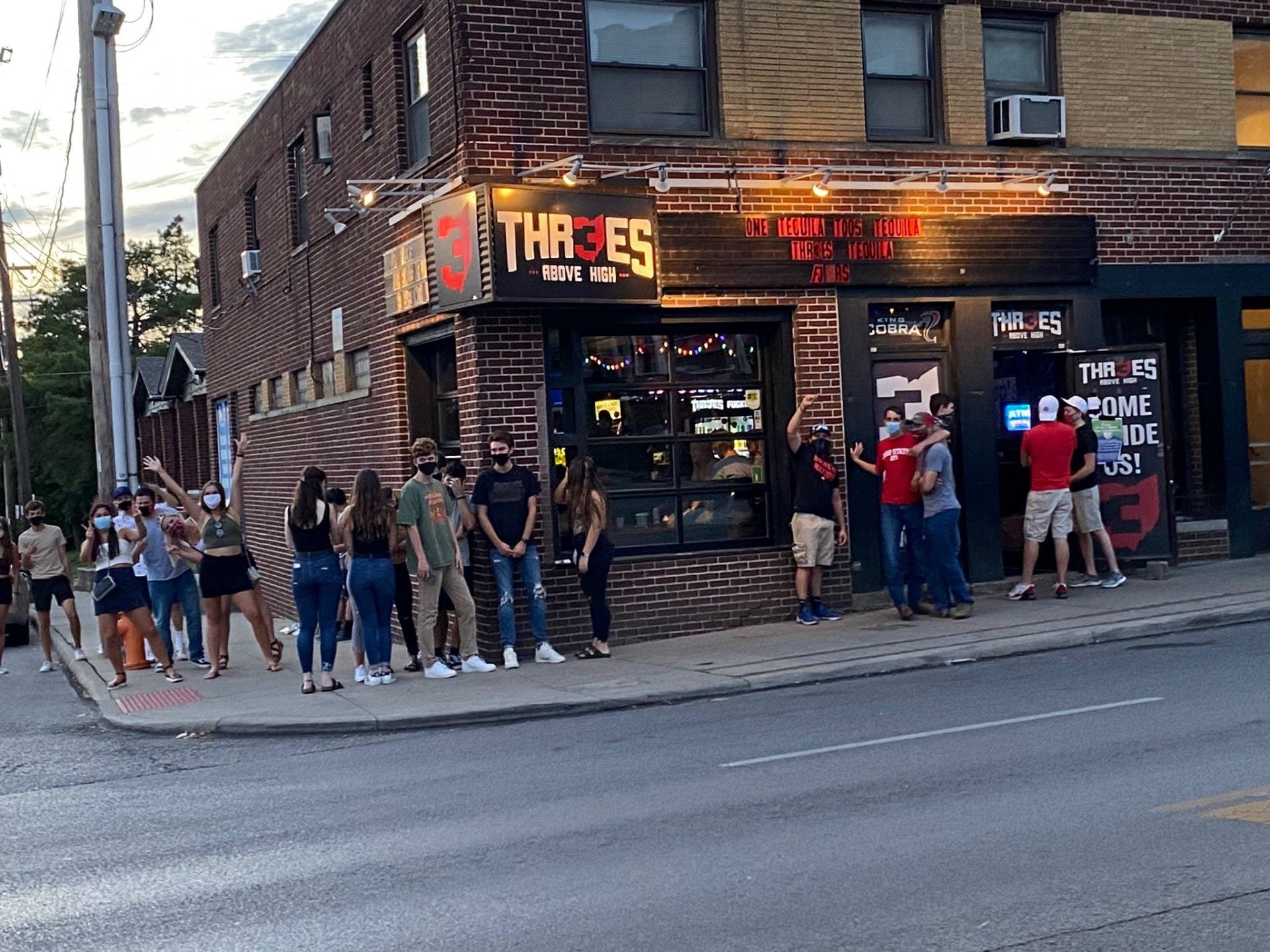
Students wait outside of Threes Above High. Columbus City Council voted Monday to repeal a city ordinance that prohibited the sale of food, beer, wine and liquor at bars and restaurants after 10 p.m. to prevent the spread of COVID-19. Credit: Courtesy of Scott Ellsworth
Ohio State students may soon resume their late-night bar adventures and keep their tabs open past 10 p.m.
Columbus City Council voted Monday to repeal a city ordinance that prohibited the sale of food, beer, wine and liquor at bars and restaurants after 10 p.m. to prevent the spread of COVID-19. The state’s ban on liquor sales after 10 p.m. is still in effect, and the council’s vote will not hamper the city’s ability to enforce the statewide ban, Lara Baker-Morrish, chief counsel for the Columbus city attorney’s office, said.
The ordinance, effective July 28, was meant to curb transmission of the virus among the 20-29-year-old demographic, which at the time had the most confirmed and probable cases of COVID-19 in Columbus.
The number of positive cases in Columbus has trended downward since early September, according to data from Columbus Public Health. Ohio State’s student cumulative positivity rate has also been decreasing since early September, according to the university’s COVID-19 dashboard. The two zip codes in Franklin County that encompass Ohio State and off-campus areas have the highest positivity rates of any other zip code in the county.
Dr. Mysheika Roberts, Columbus health commissioner, said the city’s COVID-19 cases have decreased “dramatically” as a result of the city’s ordinance in July and other preventative health measures enforced by the city.
She said cases among people above the age of 21 have dropped by 50 percent.
“That’s not just due to the action of bars having to have their last call early, but all the other actions we’ve taken including wearing your mask, practicing that social distancing, staying home when you’re sick and not having large gatherings,” Roberts said.
However, Roberts said the city will revisit the repeal of the 10 p.m. curfew if COVID-19 cases begin to trend upward in Columbus.
The statewide ban was met with criticism from campus-area bars that said many would struggle to survive.
A repeal may happen soon, as Gov. Mike DeWine said Sept. 29 that the statewide ban was under review because it cut into bars’ and restaurants’ profits.
Dan Starek, owner of Oldfield’s North Fourth Tavern and Leo’s on the Alley, said if the state repeals the rule, it will help preserve businesses that are at risk of shutting down due to revenue loss.
“If they rescind it even just a few hours, it will mean the difference between life and death for small businesses all across the state,” Starek said.
Matt Barnett, manager of The Little Bar, said the city’s decision will allow it to boost its sales and maintain social distancing, as customers can come in and out at more dispersed intervals.
“If we were able to go back to that 2 a.m. (closing time), we could bring in more customers through a wider range of time and that would definitely impact us positively,” Barnett said.
Some bar owners, however, are skeptical about the efficacy of the city council’s decision to repeal the ban on alcohol sales after 10 p.m.
Quinn Allen, owner of The Library Bar, said he does not see the state repealing its ban any time soon and doesn’t think lifting the city ban will do much.
“It’s really just not gonna move the needle about this,” Allen said. “It seems like a public stunt.”
Allen said The Library Bar and its customers are doing an “overwhelmingly good job” following COVID-19 rules and regulations and doesn’t think the 10 p.m. curfew on alcohol sales helps to quell the spread of the virus.
“I think that the hospitality establishments are a safer place overall than people inviting friends over to their houses,” Allen said.
Starek told The Lantern in July that the ban would greatly impact business for campus-area bars. He said that for many bars, 90 percent of sales are made after 10 p.m. Scott Ellsworth, owner of Threes Above High, said in July that at least 80 percent of his business’s sales occur after 10 p.m.
However, when the 10 p.m. ban went into effect, students changed how they partied.
Starek said in August that students no longer end their night at the bars. Instead, they get as “drunk as possible” before cut-off and go to house parties.
“I think people are drinking during the day at their place, then going to the bar and then trying to get drunk drunk and do shots and do liquor — and we’re selling a ton more liquor than we are beer right now — and then heading to a party or heading to their house to drink beer after that,” Starek said.
Liquor and convenience stores near campus said students are coming in at an increased rate in order to purchase more booze for the next event.


